The Formula
Long Objects and Short Objects of Medium Dimensions, They Approach and Reproach and Move Away in Circles
April 13, 2016artist contribution,
This piece has been formulated in the context of the research project Disorderly Group Behavior in Public Space which started in 2014 in Amsterdam. The text and diagrams were presented at the closing event of Culture of Control on 13 December 2015 at Stroom Den Haag.1 Mob sexual attacks are handled here as one example of group behaviour that can get out of control at any time and at any place; It goes beyond any specific incident. Having said that, I would like to condemn the appropriation of such struggles for the sake of racist and political arguments.
It is raining, said Althusser, about the ordinary rain.
To the ordinary person, said De Certeau, to the common hero. To the ancient hero who murmurs the voice of societies. To the hero who always comes before texts. To the hero who does not expect representation, who does not accept mediation. To the hero who moves away from the actors to the chorus to settle on the mass of the audience. To the ordinary person.
It is raining, the raindrops fall, they fall into the void, they swerve in the fall, and the swerve may cause an encounter, and the encounter may never last.2
In memory of the dispersed.
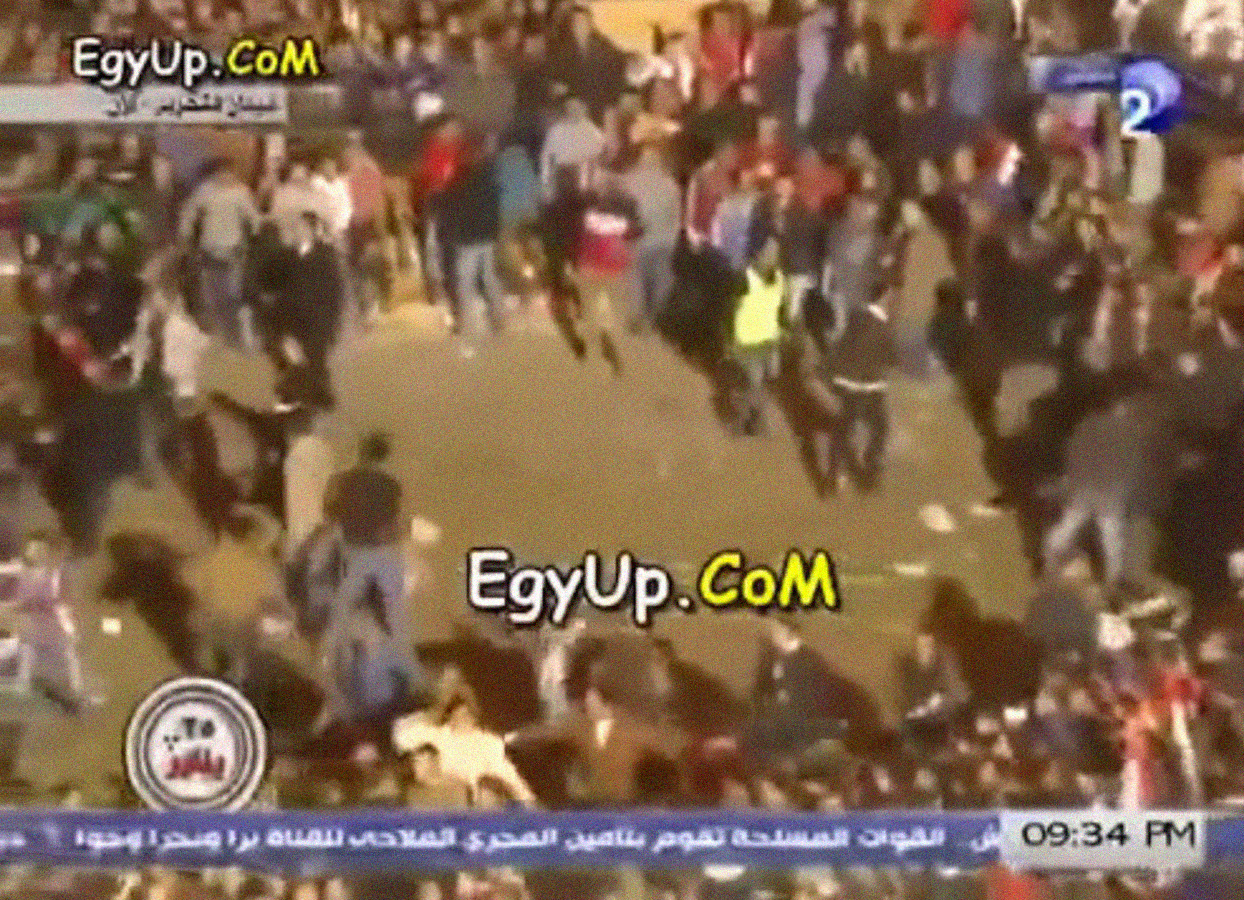
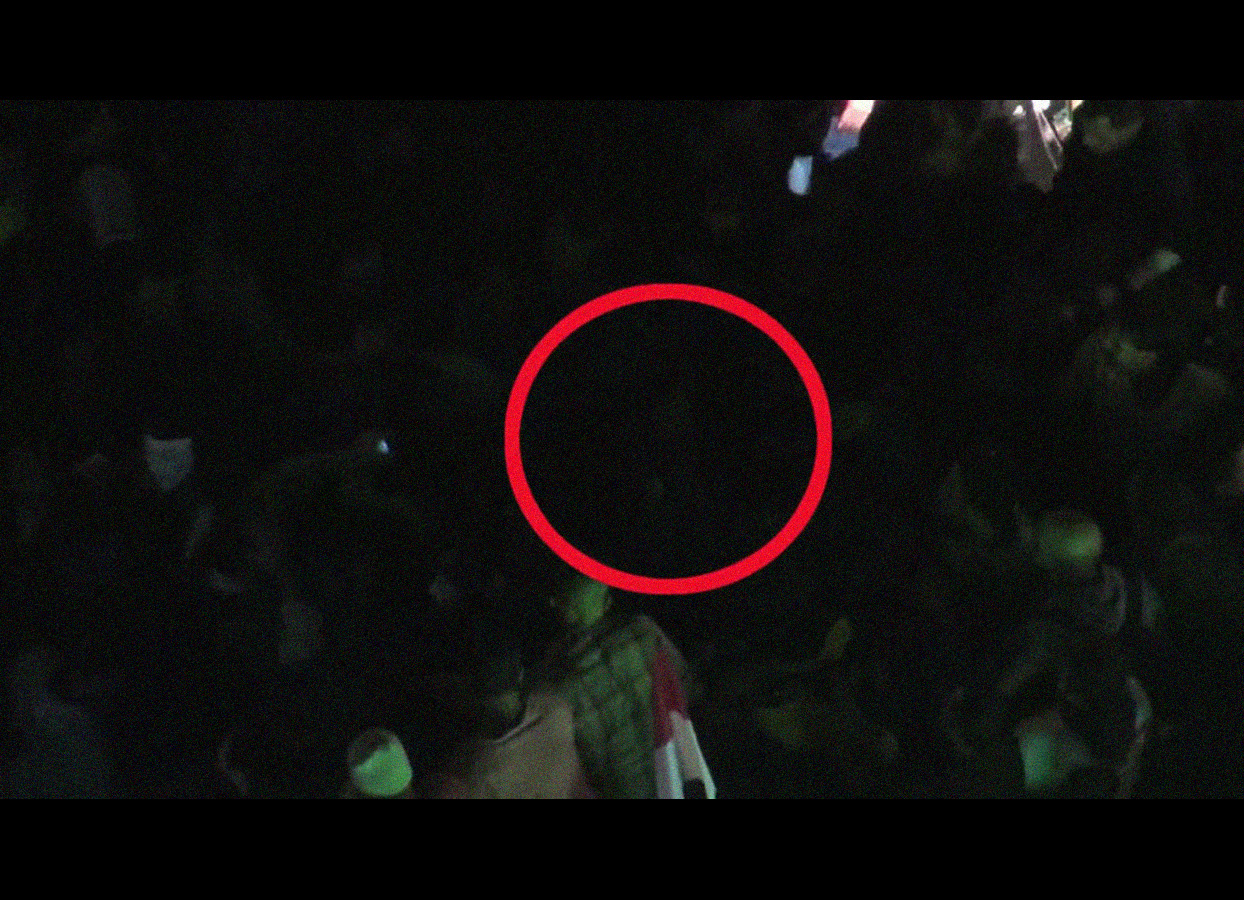
Let’s say that these are not images. These are not forms discussing an unrealized and unorganized method of escaping from something, something as simple as a little displacement, something as simple as a point, a moving point, a fixed point, an end point, or quite endless, a circle.
Let’s say that it is not a discussion. It is not a simple rational discussion about determination, about confusion, about depth, about running away from home and running away from guns, from familiar faces, from old women and young men, from one’s own belonging, running together but alone, running away and alone from a certain piece of land.
Let’s say that it is not about the physical, the physical grabbing, grabbing on something and being grabbed, resorting to the dark, a dark tunnel, or is it a dark bridge at night? Sneaking into a foreign building, running up the stairs to the top, overlooking the empty city, the full city, like an anonymous heroine, overlooking this scene, from this point of view.
Now recalibrate. What is it that you are looking at? Did you understand what it was when you were on the ground? Did you understand the meaning behind the physical touch?
From the mother to the state to the authoritarian to the oppressor; who are you running away from? Have you already started running? If yes, when exactly did you start?
Let’s say this is not about control. It is definitely not about breaking out of control. It is not about love. Not about passion, not about a possession, not about belonging, not about an encounter that carries magnificent potential, so magnificent, almost scary. Will it last? Yes, death is always in the picture, a topic of discussion, of a rational discussion, of reasoning.
Stop asking me questions about discourse, about history, about eternity, about definitions… about meaning.
Stop thinking of yourself as liberated from judgment.
Try to make sense out of this:
The Script
- A grouping of physical moving and fixed human male civilian middle and lower class youth middle age and old objects against a physical fixed non-human object to trap a physical fixed human female civilian youth object using physical moving non-human objects in the incidence of trapping.
- Physical moving human male civilian middle and lower class youth middle age and old objects pushing two physical moving human male and female civilian upper and middle class youth objects against a physical fixed non-human object in the incidence of attacking.
- Regrouping of physical moving human male civilian middle and lower class youth middle age and old objects by a physical fixed non-human object in the form of a dispersed circle in the incidence of escaping.
- Physical moving human male civilian middle and lower class youth middle age and old objects pushing a physical moving human female civilian upper and middle class youth object using physical moving non-human objects which caused physical fixed non-human objects to tear down in the incidence of getting lost.
Let’s say that it is not an event, not a Facebook event, not a Badiouian event, not Žižek’s event, none of these. It is so insignificant, too personal to the extent that it almost became flat basic, and because all the persons are related, it became one big person, like a body, rising up and floating over the space, let’s say the scene, in a manner that made a cloud out of it, a mass. When you are on the ground and totally surrounded, you are isolated and almost suffocated, imperiled with a loss of understanding, too strong that it escalates to a loss of consciousness, quite physical, a physical loss, but still moving. Something like losing consciousness whilst on adrenaline, sometimes a real drug. You are not sure what causes your nausea. What kind of drug, innate or taken? What kind of cloud, heat or smoke? What kind of touch, assaulting or rescuing? What causes movement, a crowd or a gang?
Now recalibrate. From above the foreign building on which you are standing, from this point of view, can you breathe? Yes? But can you feel anything? One sense cancels the other. All senses together at one time, they explode. You only see the cloud, very fat, very flat, very fast, swiftly stagnant, with indicators moving underneath it. You try to make sense out of it. Did you make sense out of it when you were on the ground? On adrenaline? From the point of view of the foreign building you have the strength to observe and describe.
Same location, different year.
Same scene, different description.
Now, stop asking me questions about discourse, and history, and meaning.
Liberate yourself from judgment.
Try to make sense out of this:
The Footage
- a policeman smoking a cigarette with a loaded gun in his raised hand
- a guy with a sword
- several men with wooden and metal sticks
- members of a rescuing group in yellow vests
- harassers
- a girl who is being sexually attacked
- a thin white thread stretched across the shooting frame
The IRT (in real time) narration of the footage on air is a conversation between the host and a guest about an irrelevant topic.
Additional info:
Title: Live Stream – Commemoration of an Anniversary, Location: a street in a square, Date: 25‑01‑2014, Time: 9:34 pm, Amount of people: (unknown), Age: (unknown), Event: (unknown), Sub event 1: (unknown), Sub event 2: (unknown), Sub event 3: (unknown), Sub event 4: (unknown), Gender: (unknown), Legal status: (unknown), Substance: (unknown), Motion: (unknown), Nature: (unknown), Religion: (unknown), Class: (unknown).
Let’s say we take off from the idea of the ‘physical’ on the occasion of dealing with people as a collective group. Let’s say we observe, document and analyze the idea of ‘reactionary behaviour’ that is triggered by ‘objects’ in the form of ‘layers’. Let’s assume that all types of behaviour in the context of the public event are managed by and can be described through a trilateral relation between: objects, transitions and layers. A chain of action and reaction is triggered by the object, which means that there is a ‘blueprint’ of the object that could be named as the first layer. This chain can be traced backward or forward if it is manageable to identify the ‘reasons’ for transitions between the layers. Maps can be drawn to capture the physical relation of the object(s) in specific layers, and also to capture the dynamics of the ‘transition points’, which are the reasons for reformation of objects into new layers. Let’s say that the postulation is as follows: if this formula and diagrammatic index were successful in creating a general manual for this sequence of reactionary behaviour, then it is theoretically possible to predict and eventually change the scheme of the process.
Now, liberate yourself from judgement.
Try to make sense out of this:
The Definitions
- Objects: are the constituents / basic components of layers.
- Layers: are the geometrical fixed forms / shapes of groups of objects.
- Transitions: are the dynamic reasons / causes / incidences / actions behind the regrouping / rearrangement of objects from one layer to the other.
- The sequence: is the process / chain reaction of transitions.
- The event: is the name of the umbrella under which the sequence takes place. There usually is one main event and several sub-events.
- The formula: is a written equation that describes the sequence of the event in terms of (objects, layers, and transitions). The basic formula describes one transition [layer (1) + transition + layer (2)]. The composite formula describes the whole event in the form of successive basic formulas.
- The diagram: is the visual representation of the formula.
Let’s say we take off from the idea of ‘abstraction’ and ‘flattening’ and at the same time ‘concentration’ of collective (and eventually individual) experiences into a corpus of objective knowledge. Consider this as a process of creating history, not truth, through documenting and restoring events in the form of files and numbers, and naturally transforming people and whatever affect that lies within them, and within those occasions, into reproduced and standardized narrations. Let’s say we produce glitches, visual and assimilative, senses of comprehension.
Let’s say we take off from the idea of dehumanizing collective and individual experiences. A documentation and a description of mass events, a process that could be approximated to an unscientific work by an anthropologist and that could result in a banal study. Let’s say we collect a set of material evidence, of aerial footage, of testimonies, and use them to create a dictionary in the form of charts which could translate any kind of event into a formula.
Let’s say the formula is then a representational tool using our own script.
Let’s say that these translations are meant to analyze and try to minimize, and then express objectively, both in verbal and visual languages, sequences of reactionary behaviour.
Let’s say it opens up fields of subjective interpretation.
Let’s say it doesn’t work. It will never work. Let’s say we ignore this fact as we always do.
Now, try to make sense out of this:
The Formula*
[verb] of [object] by [object] into [layer] caused by / in the incidence of / for [transition]
* For each one of the terms that constitute the formula of an event, a dictionary in the form of a chart is created in order to be used to fill in an objective format of description.
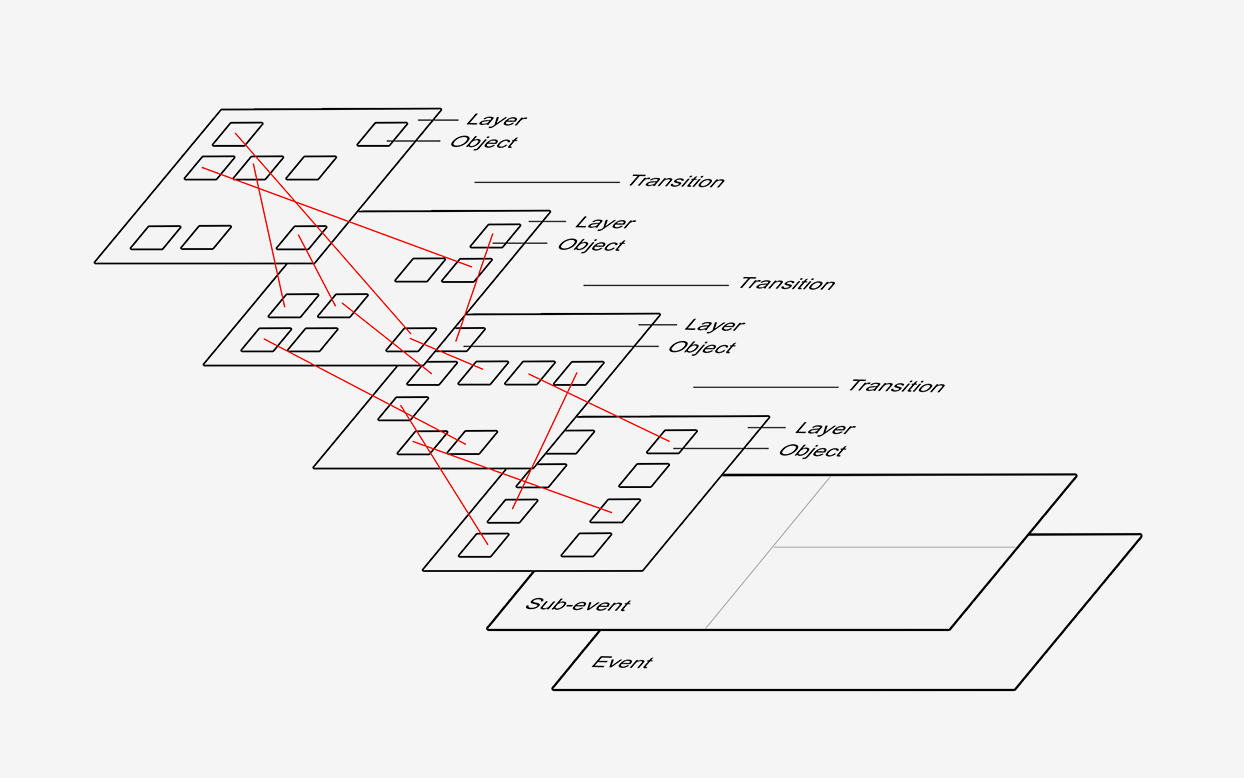
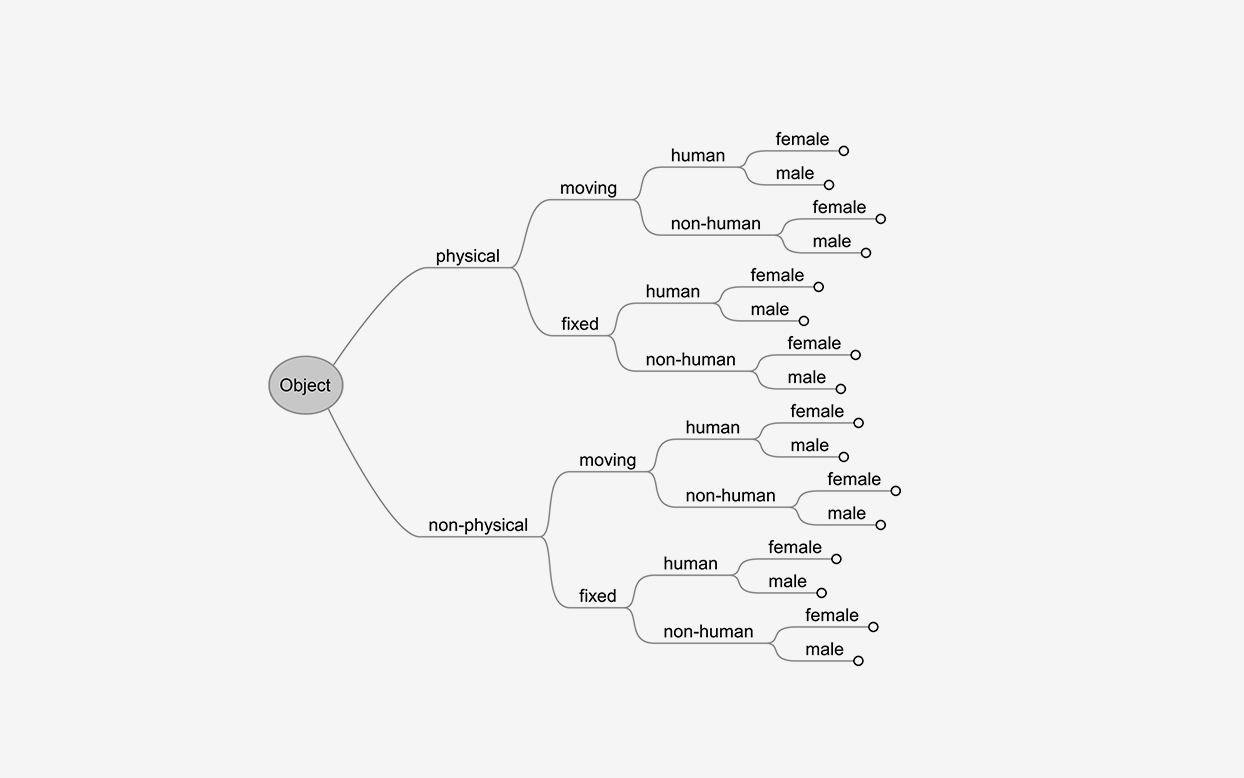
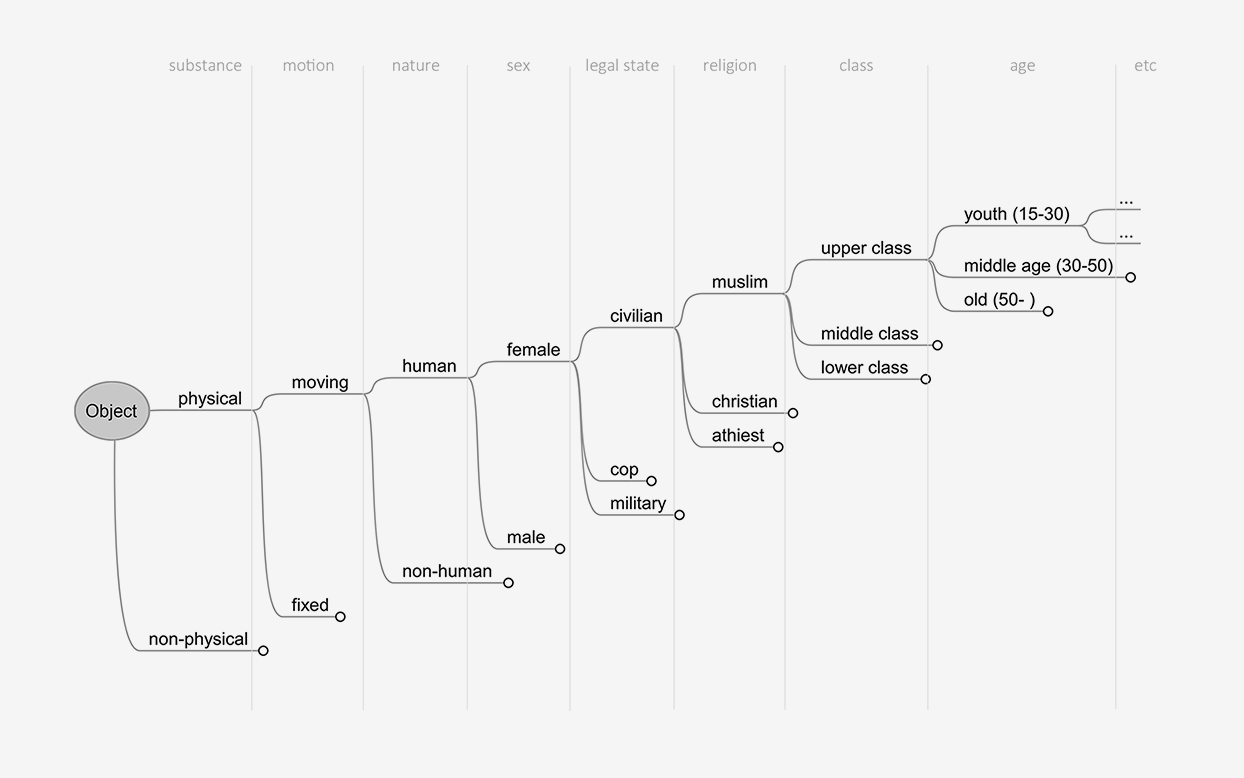
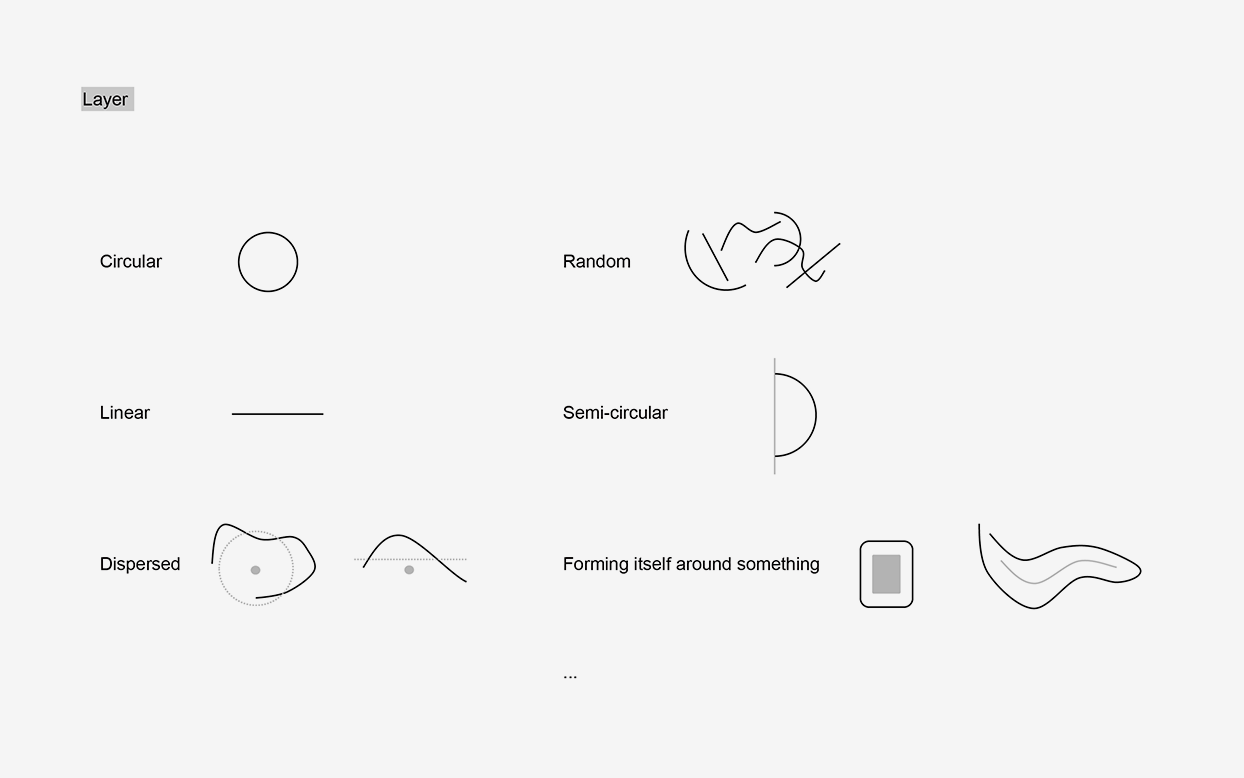
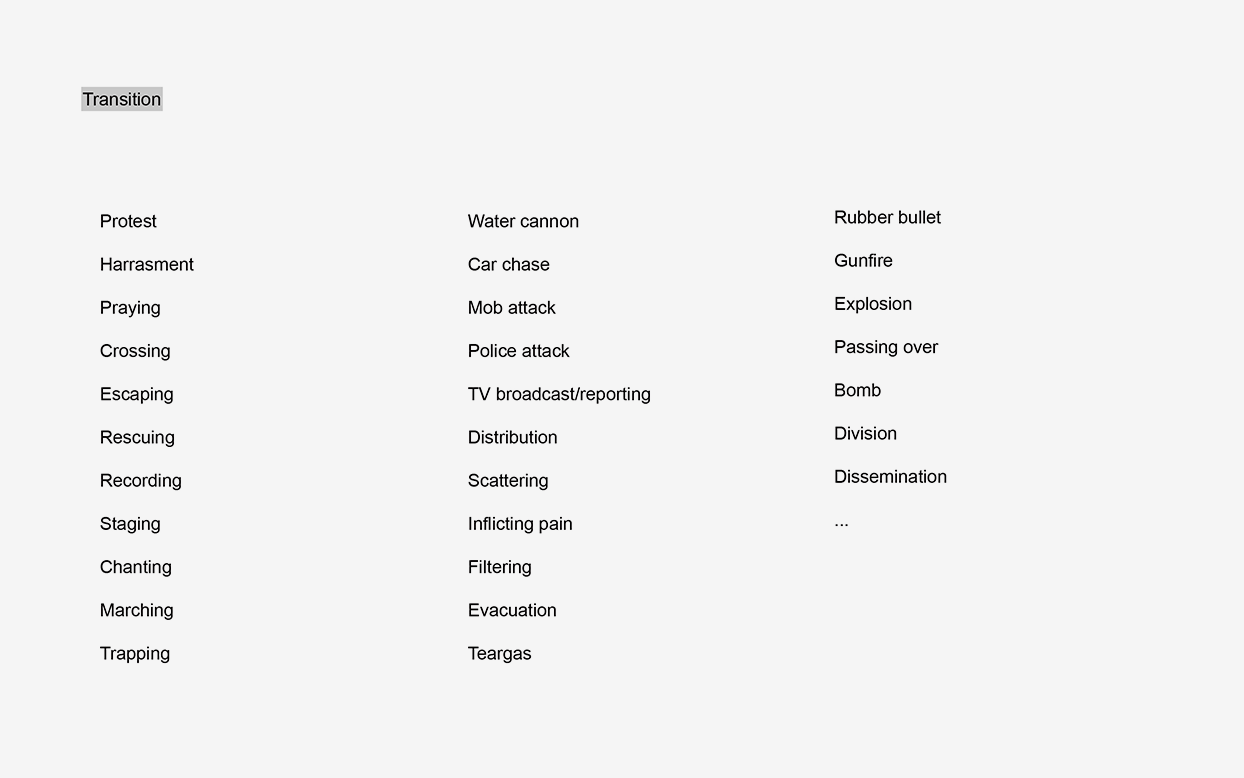
Now stop being pragmatic.
Chase this scene. A movement in the dark, some occasional renderings, a story in scenes, several scenes, several noises, some music, some murmurs in the background, footage that is claimed to belong to the scene, a drafted script based on the testimony, the footage overlaid on the testimony that is overlaid on the script, a juxtaposition, a manipulation, a manipulation of the speed of the footage, faster, slower, faster, a repetition, a stop, a rewind.
A female voice, a tone, a specific tone, a red circle, swiftly moving, also chasing the scene, in the dark, it disappears and reappears abruptly, a flare, another flare, several flares against a thick line, a thick green line stretched across the shooting frame, a thick yellow line stretched across the shooting frame. A directional movement in the shape of a straight line, a coming back, an agglomeration, a cut, a repetition, an endless repetition, a massive flashlight, a massive agglomeration, a suction, a disappearance into the building, a door wide shut, that same foreign building, maybe a different one, you run across the hallway, all the way up the staircase, you run out of breath, you reach the top, from there, from that point of view, you reclaim your body, you reclaim some of your senses, everything feels like a distant wave, your heartbeat slows down, you calm down just a little bit, you shoot.
End point, starting point. Now recalibrate.
Try to make sense out of this:
The Translation
First scene: Yelling and screaming noises 1. Some people 2 ran toward us saying that there’s a harassment incident taking place in front of Safir. We ran to Safir and found a huge crowd 2 pushed against the fence 3. We tried to pass through them but people 2 were using batons 4 and belts 4, until I was able to reach the girl 5.
Main event: Protest
Sub event: Mob sexual harassment
Objects:
1 non-physical moving human civilian objects
2 physical moving and fixed human male civilian cop and military upper middle and lower class youth middle age and old objects
3 physical fixed non-human object
4 physical moving non-human objects
5 physical fixed human female object
Layer: Crowd against fence 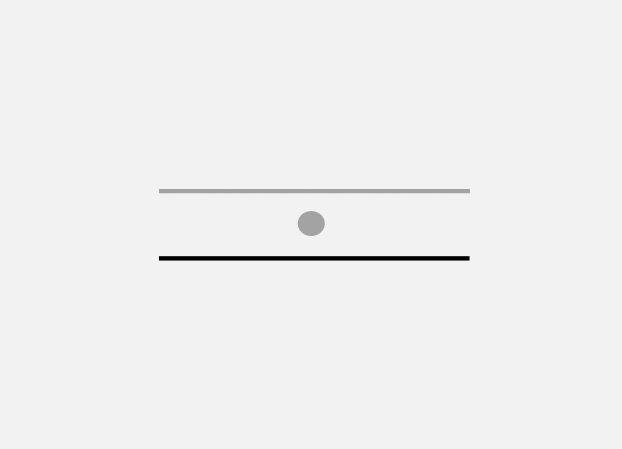
Transition: Trapping
Formula: Grouping of physical moving and fixed human male civilian cop and military upper middle and lower class youth middle age and old objects against a physical fixed non-human object to trap a physical fixed human female object using physical moving objects in the incidence of trapping.
Third scene: A flare 1 exploded that forced everyone to move back, the number of people 2 and the pushing lessened a bit, however, there were still a number of people 2 surrounding her 3. We 4 started moving with her 3 slowly toward Talaat Harb so we could let her into any building 5.
Main event: Protest
Sub event: Mob sexual harassment
Objects:
1 physical fixed non-human object (1)
2 physical moving human male civilian cop and military upper middle and lower class youth middle age and old objects
3 physical moving human female object
4 physical moving human male civilian upper and middle class youth objects
5 physical fixed non-human object (2)
Layer: Dispersed crowd 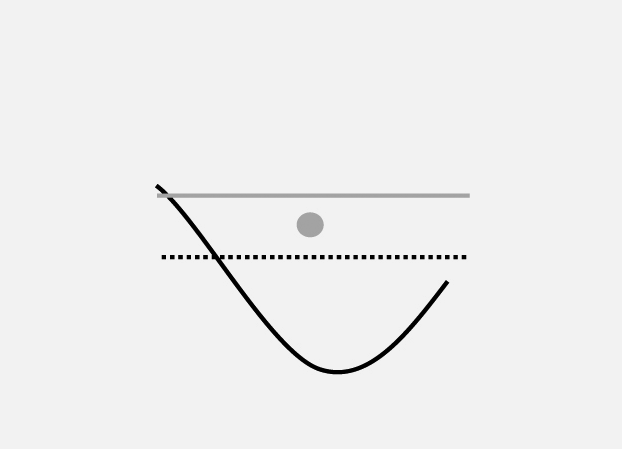
Transition: Escaping
Formula: Regrouping of physical moving human male civilian cop and military upper middle and lower class youth middle age and old objects by a physical fixed non-human object in the form of a dispersed circle in the incidence of escaping.
Now stop being romantic. Actually, this was not all just stream of consciousness.
Imagine two scenes happening at the same location, on the same day, in two different years. They have been chosen from a collection of evidence about public events. One of the two scenes is an alleged mob sexual attack. For this scene a testimony has been published online. The testimony of the scene has been divided by the original narrator into sixteen scenes. The one testifying is a member of an anti-sexual harassment group who witnessed and took part in the event. The testimony was written and translated by a different person.
Imagine that this specific scene, which came to consist of sixteen scenes, was made into a movie that was launched on the YouTube channel of the anti-sexual harassment group. Activists used the testimony as a base for a written scenario. The scenario provided the narration for footage they made and which they identified to be of the actual attack. The narrated video was presented in an effort toward the documention of the event. The script was narrated by a female voice that intended to be provocative in order to raise awareness about the topic, insisting on the fact that similar incidents are present and should be brought to light instead of being covered up and silenced. The work was very explanatory, very romanticized, very dreamy, very obscure and very suggestive.
Imagine that you examined the footage and could not make sense out of it.
Imagine that you see a connection between this footage and that of the other scene which had taken place in the same location, on the same date, one year later, and which contrary to the previous scene, was aired on national TV but was completely neglected. Not a single effort was made to draw attention to the scene, even at the time it was aired. Imagine that you could not make sense out of what you saw but could recognize a similar set of objects as the ones mentioned in the testimony. Imagine that the narration brought a new life to the footage, and to the scene itself. Imagine that you attempt to translate the scene again, and again, into the formula. Imagine it not to be an easy task. Imagine it to still be very suggestive.
Imagine that by examining the footage of those two events and the narration that accompanied them, you find similarities regardless of the content or intention of the narration, of the medium and context in which they are presented, and regardless of the difference in occasions.
On occasions of pubic mass events, when things go wrong, most probably they also go inexplicable, and the narrative voice, which is documenting in real time, starts playing arbitrary but theatrical roles: a football match becomes a battle field, public space becomes a crime scene. The narrative voice that represents and documents gets recorded and imprinted with an equal force and power to that of the bare scene itself.
The outcome of this is always unclear and uncertain but is considered necessary for tangibility. Those representations could be regarded as accepted experiments in the process of creating subjective representations using seemingly objective tools.
Imagine that the current postulation is as follows: If the idea is to create objective tools (formula) by using subjective methods (collected material) and then to use those tools to translate subjective descriptions (representations), then the process becomes – in a way – a disguised subjectivity or an intended objectivity that would make the outcome unrecognizable for both familiar and foreign eyes.
It is no longer a statement of the Reason and Origin of things, but a fact of the forms which ‘give form.’ It is now no more the ‘observation’ but the ‘crystallization’ of elements with one another. All questions of origin are rejected, as are all the great philosophical questions.3
1. The research project Disorderly Group Behaviour in Public Space, initiated by architect Elmo Vermijs, was formed by participants from the School of Missing Studies, a former Master’s program at the Sandberg Institute in Amsterdam. Members of the research group developed separate individual projects aiming to examine the topic from an architectural and socio-psychological perspective. The closing event of the exhibition SHOW MORE, part of the programme of Culture of Control at Stroom Den Haag, was dedicated to displaying the results of this research.
2. See Louis Althusser, Philosophy of the Encounter: Later Writings 1978–1987 (London: Verso Books, 2006), 170 and preface to Michel De Certeau, The Practice of Everyday Life (Berkeley: University of California Press, 1984).
3. See Althusser, Philosophy of the Encounter.
Abla elBahrawy is an architect and researcher from Cairo. Her practice oscillates between architecture, archaeology and art. She recently graduated with an MFA from the School of Missing Studies at the Sandberg Institute in Amsterdam and is artist in residence at the Jan van Eyck Academie, Maastricht from 2016–2017.